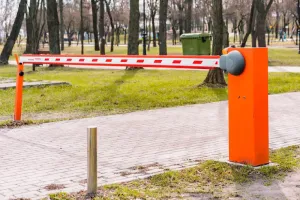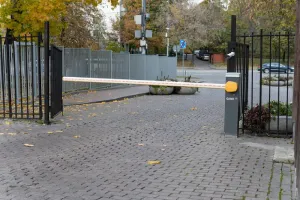Types of Physical Barriers (Bollards, Gates, Doors)
Physical barriers are one of the first lines of defence in any security strategy. As a Security Control Room (SCR) Operator, you may not always be physically on the ground, but your role in monitoring, coordinating, and responding to incidents involving these barriers is critical. Understanding how bollards, gates, and doors function, and their role within wider security frameworks, ensures you can make better operational decisions, provide accurate information to officers on-site, and support compliance with UK standards.
Why Physical Barriers Matter
Physical barriers are not just about stopping people or vehicles, they are about controlling access, delaying threats, and ensuring safety. The Security Industry Authority (SIA) and Approved Contractor Scheme (ACS) highlight that effective access control is a core element of professional security operations. Additionally, British Standards (such as BSI PAS 68 for vehicle security barriers) and the National Security Inspectorate (NSI) Codes of Practice provide best practice guidelines for installation and management.
If barriers fail, whether due to poor maintenance or misuse, there can be serious consequences, including breaches, theft, or even terrorism-related incidents. As an operator, your ability to understand their role means you can escalate issues quickly and avoid costly or dangerous outcomes.
1. Bollards
> What They Are
Bollards are short, sturdy posts designed to prevent vehicles from entering restricted areas. They may be fixed, retractable, or removable.
Real-World Example:
Imagine a shopping centre car park where retractable bollards are used to separate delivery vehicles from public spaces. If these bollards are not raised at the right times, unauthorised vehicles could enter pedestrian zones, creating safety risks.

Key Considerations:
– Compliance: Many bollards must meet PAS 68 standards for impact resistance.
– Monitoring: CCTV should cover areas where bollards are raised or lowered.
– Tips: Always verify bollard functionality reports from on-site officers and log faults immediately.
Consequences of Failure:
If bollards are left down during a high-profile event, it could allow a hostile vehicle through, leading to potential injury or reputational damage for the client.
2. Gates
> What They Are
Gates provide controlled access for vehicles or pedestrians into secured sites. These may be manual, automated, or integrated with access control systems.
Real-World Example:
In a corporate office park, the main gate is linked to an ANPR (Automatic Number Plate Recognition) system. As an SCR operator, you might receive an alarm if an unrecognised vehicle attempts entry. Knowing how to verify and respond is essential.

Key Considerations:
– Compliance: Gates must align with Health and Safety legislation to avoid trapping or crushing hazards.
– Integration: Often linked with access control databases and CCTV.
– Tips: Always check gate logs against visitor management systems to detect anomalies.
Consequences of Failure:
If a gate malfunctions and remains open overnight, unauthorised access could lead to burglary or vandalism, with insurance claims possibly being denied if systems were not properly monitored.
3. Doors
> What They Are
Doors are the most common form of physical barrier, separating secure from non-secure zones. They may include reinforced fire doors, electronic access-controlled doors, or blast-resistant doors.
Real-World Example:
In a hospital, a controlled drugs room may use an electronic door system with swipe cards. If you see multiple failed access attempts on your system, it could indicate someone attempting unauthorised entry.

Key Considerations:
– Compliance: Must meet British Standards for fire safety and security (e.g., BS 476 for fire resistance).
– Integration: Often connected to alarm systems, access cards, or biometric readers.
– Tips: Watch for “door forced open” or “door held open” alarms, and always follow escalation procedures.
Consequences of Failure:
If a secure door to a data centre is left ajar, sensitive information could be compromised, leading to GDPR breaches and fines.
Operator’s Golden Rules
Double-check everything: Never rely solely on system readings, always back it up with CCTV or an officer’s eyes on the ground.
Keep clear records: Logging incidents, faults, or unusual activity is not just paperwork, it’s protection for you and the client.
Act fast when needed: Delays in escalating a barrier fault or suspicious activity can turn a minor issue into a major breach.
Safety before property: Remember, protecting people always comes first. Assets can be replaced, lives cannot.
Did You Know?
The Centre for the Protection of National Infrastructure (CPNI) has shown that over 70% of hostile vehicle attacks in the UK happened where barriers were weak or missing.
The British Security Industry Association (BSIA) found that nearly 40% of access breaches were due to poor maintenance of gates and doors.
These figures show that barriers aren’t just structures, they are life-saving tools when managed properly.
Test Yourself: What Would You Do?
Scenario: You’re monitoring a distribution centre after hours. An HGV approaches and the bollards don’t rise. The driver insists they have a delivery, but the lorry has no company branding.
Do you trust the driver and let them through?
Do you check the delivery schedule first?
Do you contact on-site officers for confirmation?
Do you hold the barrier closed until everything is verified?
The right response is to verify before allowing access. Trusting appearances without checks could put staff and assets at risk.
You Are the Barrier’s Strength
Being an SCR Operator is never just about staring at monitors, it’s about being the living, thinking part of the security system. Bollards, gates, and doors may be built from steel and reinforced materials, but without your vigilance they are only half as effective.
By staying alert, following procedures, and working in line with SIA, ACS, BSI, and NSI expectations, you become the difference between a barrier simply existing and a barrier actively protecting.
Always remember, a barrier is only as strong as the operator guarding it, and that operator is you.

